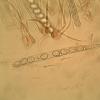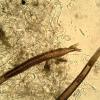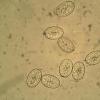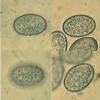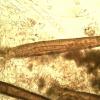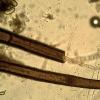
20-12-2025 23:08
Patrice TANCHAUDBonsoir, récolte sur sol sablonneux dans l'arri�

20-12-2025 15:47
Mirek GrycHi.These grew on pine wood that was heavily covere

18-12-2025 21:17
Pol DebaenstThe identification took me to Byssonectria deformi

15-12-2025 07:09
 Danny Newman
Danny Newman
indet. Rutstroemiaceae sp. on unk. fallen leavesMc

19-12-2025 10:10
Patrice TANCHAUDBonjour, récolte réalisée en milieu dunaire, a

18-12-2025 17:23
 Bruno Coué
Bruno Coué
Bonjour,je serais heureux d'avoir votre avis sur c

18-12-2025 18:07
Margot en Geert VullingsThese plumes were found on rotten wood.They strong

17-12-2025 18:35
 Michel Hairaud
Michel Hairaud
Bonjour à tous/Hi to everyone I am passing along
Scutellinia
Malcolm Greaves,
21-05-2013 18:55
The spores averaged 18.5 x 12.3 and had small sometimes interconecting warts.
There were three distinct types of hair, firstly long 1200um then short 250 -400 and finally very short and rounded.
This lead me to S critina but the unusual find was that some of the small hairs were growing inside the longer ones. On checking Schumacher it is apparently not unusual and cannot be used in helping to identifying to species but it is the first time I have seen it.
Mal
Michel Delpont,
21-05-2013 20:14

Re : Scutellinia
Good evening Malcolm
Your fungus also makes me think S.crinita I harvested a few days ago. Beautiful species with the long hair.
Michel.
Your fungus also makes me think S.crinita I harvested a few days ago. Beautiful species with the long hair.
Michel.
Beñat Jeannerot,
21-05-2013 21:03

Re : Scutellinia
Dear Malcolm,
S. crinita.
About hairs inside others, it's a very common fact in this genus. Not a discriminate factor.
Regards,
Beñat
S. crinita.
About hairs inside others, it's a very common fact in this genus. Not a discriminate factor.
Regards,
Beñat


